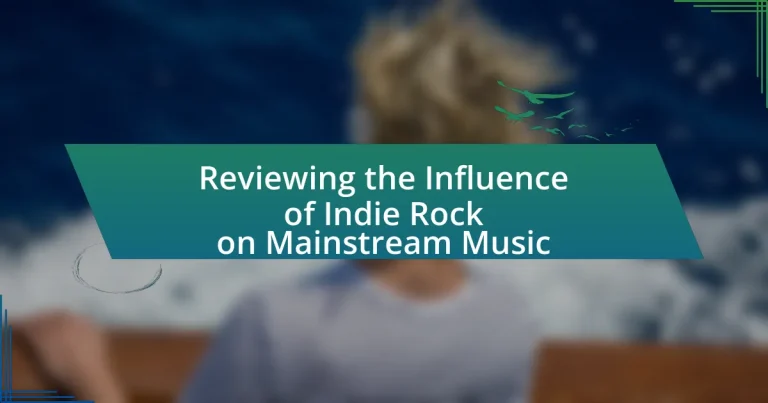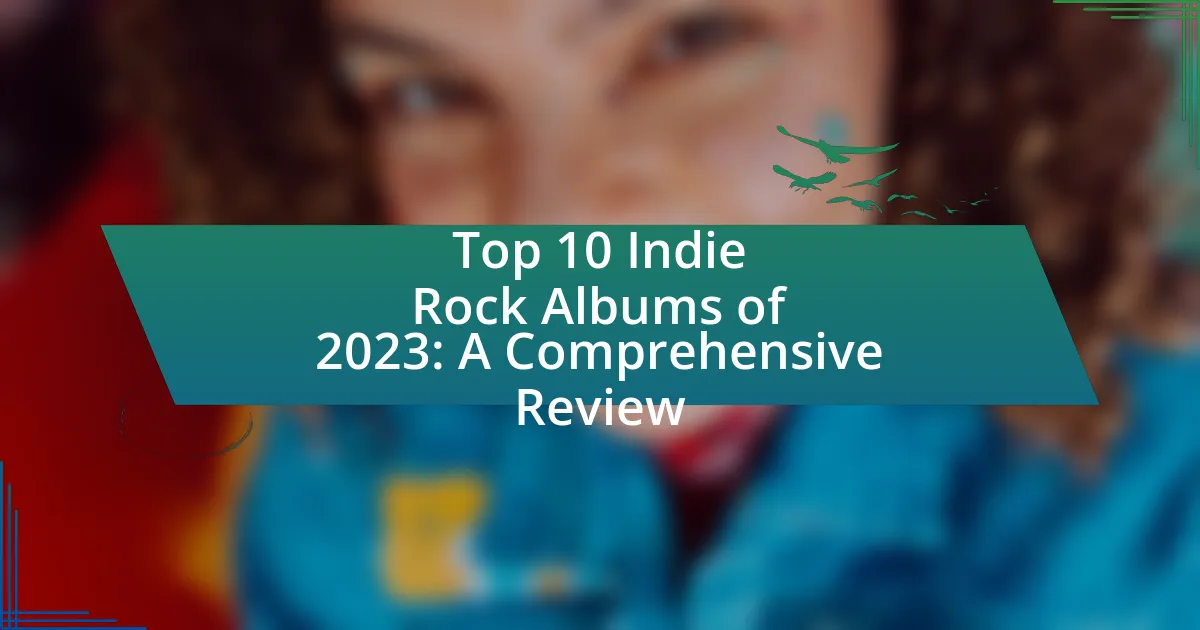The article reviews the influence of Indie Rock on mainstream music, highlighting its emergence in the 1980s as a response to commercialized rock and its defining characteristics, such as a DIY ethos and diverse musical styles. It discusses key artists like R.E.M., Radiohead, and The Strokes, who have shaped the genre and impacted mainstream trends by introducing unconventional song structures and lyrical authenticity. The article also examines how the digital age and streaming platforms have facilitated the crossover of Indie Rock into mainstream music, leading to collaborations that enhance both genres’ visibility and appeal. Additionally, it explores current trends and future expectations regarding the relationship between Indie Rock and mainstream music, emphasizing the ongoing blending of styles and the strategies Indie artists can employ to maintain relevance.
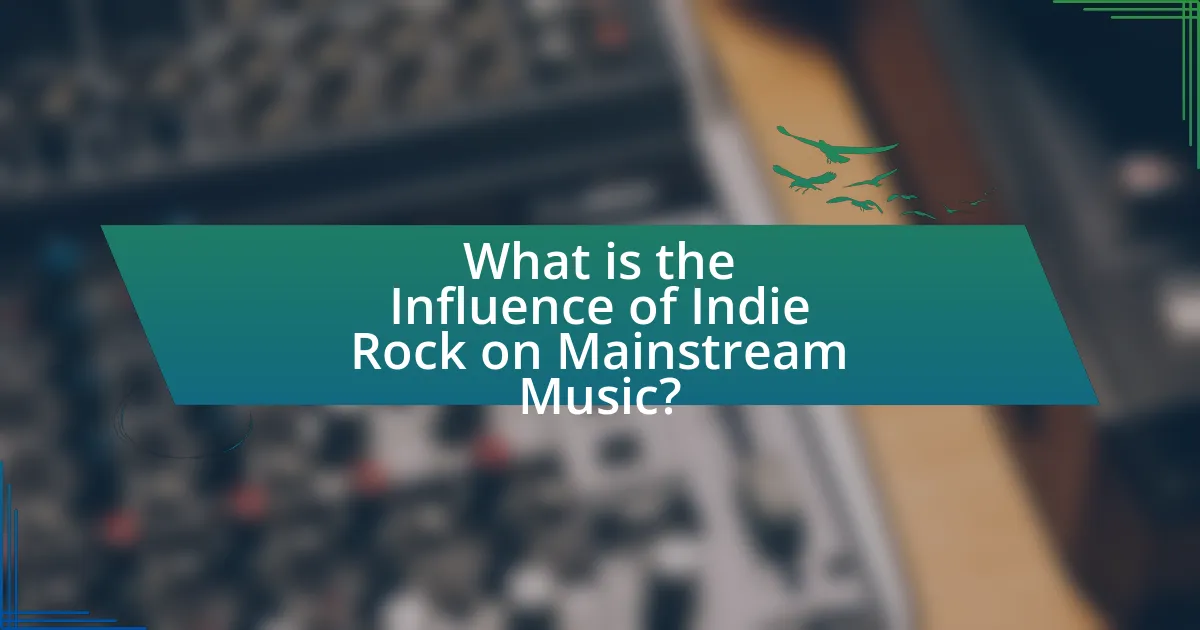
What is the Influence of Indie Rock on Mainstream Music?
Indie rock has significantly influenced mainstream music by introducing diverse sounds, lyrical authenticity, and a DIY ethos. This genre has shaped the musical landscape since the 1990s, with bands like Radiohead and The Strokes bringing alternative styles into the mainstream. The success of these bands led major record labels to adopt indie aesthetics, resulting in a blending of genres and a broader acceptance of non-traditional song structures. For instance, the rise of artists such as Billie Eilish and Tame Impala showcases how indie rock’s experimental elements have permeated pop music, leading to chart-topping hits that prioritize artistic expression over commercial formulas. This shift is evidenced by the increased presence of indie-influenced artists in mainstream charts, reflecting a cultural shift towards valuing originality and authenticity in music.
How did Indie Rock emerge as a genre?
Indie Rock emerged as a genre in the 1980s as a response to the commercialization of mainstream rock music. This movement was characterized by independent record labels, which allowed artists to produce and distribute music outside of major label control, fostering a DIY ethic. Bands like R.E.M. and The Smiths were pivotal in this emergence, gaining popularity through college radio and underground scenes, which emphasized artistic freedom and authenticity. The genre’s growth was further propelled by the rise of alternative rock in the 1990s, with bands such as Nirvana and Radiohead achieving significant commercial success while maintaining an independent spirit.
What are the defining characteristics of Indie Rock?
Indie Rock is characterized by its emphasis on independent production, a diverse range of musical styles, and a focus on artistic expression over commercial success. This genre often features unconventional song structures, a DIY ethos, and a rejection of mainstream music industry norms. Historically, bands like R.E.M. and The Smiths exemplified these traits in the 1980s, paving the way for later artists who embraced a similar approach. The genre’s distinct sound often incorporates elements from various styles, including punk, folk, and electronic music, further showcasing its eclectic nature.
How did the cultural context shape Indie Rock’s development?
Cultural context significantly shaped Indie Rock’s development by fostering a DIY ethos and promoting artistic authenticity. The rise of independent record labels in the 1980s and 1990s, such as Sub Pop and Matador, provided platforms for artists to produce music outside mainstream commercial constraints. This environment encouraged experimentation and diverse musical influences, reflecting societal changes like the counterculture movements and economic shifts. Additionally, the advent of the internet in the late 1990s and early 2000s allowed for greater accessibility and distribution of music, enabling Indie Rock to reach wider audiences and influence mainstream genres. The cultural emphasis on individuality and self-expression during this period further solidified Indie Rock’s identity, making it a significant force in the evolution of contemporary music.
Why is the influence of Indie Rock significant in music history?
The influence of Indie Rock is significant in music history because it challenged mainstream music conventions and fostered a diverse range of artistic expression. Emerging in the 1980s and gaining prominence in the 1990s, Indie Rock artists often prioritized creative control over commercial success, leading to innovative sounds and lyrical themes that resonated with audiences. This movement contributed to the rise of alternative music scenes and paved the way for the acceptance of various genres in the mainstream, as seen with bands like Nirvana and Radiohead, who brought Indie sensibilities to a wider audience. The genre’s emphasis on authenticity and DIY ethics has also inspired countless musicians, shaping the landscape of contemporary music and influencing genres such as pop, electronic, and hip-hop.
What role did Indie Rock play in the evolution of music styles?
Indie Rock significantly influenced the evolution of music styles by promoting artistic freedom and diversity in sound. Emerging in the 1980s, it challenged mainstream conventions, leading to the incorporation of varied genres such as punk, folk, and electronic elements into popular music. This genre’s DIY ethos encouraged artists to experiment with unconventional song structures and lyrical themes, which reshaped listener expectations and broadened the musical landscape. Notable bands like R.E.M. and The Smiths paved the way for later acts, demonstrating that commercial success could coexist with artistic integrity, ultimately impacting the development of alternative rock and pop music in the 1990s and beyond.
How has Indie Rock challenged mainstream music conventions?
Indie Rock has challenged mainstream music conventions by prioritizing artistic authenticity over commercial viability. This genre often embraces unconventional song structures, lo-fi production techniques, and diverse lyrical themes that diverge from the polished, formulaic approach typical of mainstream pop. For instance, bands like Radiohead and The Strokes have gained acclaim for their experimental sounds and introspective lyrics, which contrast sharply with the commercial pop music landscape dominated by catchy hooks and mass appeal. Furthermore, the rise of independent labels and digital distribution has empowered artists to bypass traditional music industry gatekeepers, allowing for a broader range of voices and styles to emerge, thereby reshaping listener expectations and industry standards.
What are the key artists and bands that shaped Indie Rock?
Key artists and bands that shaped Indie Rock include R.E.M., The Smiths, Sonic Youth, and Pavement. R.E.M. is often credited with bringing alternative rock into the mainstream in the 1980s, influencing countless bands with their jangly guitar sound and introspective lyrics. The Smiths, known for their distinctive blend of melancholic melodies and witty lyrics, played a crucial role in defining the indie sound in the UK during the same era. Sonic Youth’s experimental approach and use of alternative tunings helped to expand the boundaries of rock music, while Pavement’s lo-fi aesthetic and unconventional song structures became a hallmark of the genre in the 1990s. These artists collectively contributed to the evolution of Indie Rock, impacting both its sound and cultural significance.
Which Indie Rock bands had the most impact on mainstream music?
Radiohead, The Strokes, and Arcade Fire are Indie Rock bands that had significant impacts on mainstream music. Radiohead’s album “OK Computer” (1997) is often credited with influencing the sound of alternative rock and electronic music, leading to a broader acceptance of experimental sounds in mainstream. The Strokes’ debut album “Is This It” (2001) revitalized garage rock and influenced a wave of bands in the early 2000s, shaping the sound of modern rock. Arcade Fire’s “Funeral” (2004) brought orchestral elements into indie music, achieving commercial success and critical acclaim, which helped to bridge the gap between indie and mainstream audiences.
How did these artists influence the sound of mainstream music?
Indie rock artists significantly influenced the sound of mainstream music by introducing diverse musical styles, innovative production techniques, and lyrical authenticity. For instance, bands like Radiohead and The Strokes incorporated experimental sounds and lo-fi aesthetics that challenged conventional pop structures, leading to a broader acceptance of alternative genres in mainstream charts. Additionally, the success of indie rock acts in the 2000s, such as Arcade Fire and Death Cab for Cutie, demonstrated that emotionally resonant lyrics and unique instrumentation could achieve commercial success, paving the way for a new wave of artists who blend indie sensibilities with mainstream appeal. This shift is evidenced by the rise of genres like indie pop and alternative rock in popular music, which have become staples on platforms like Billboard and Spotify.
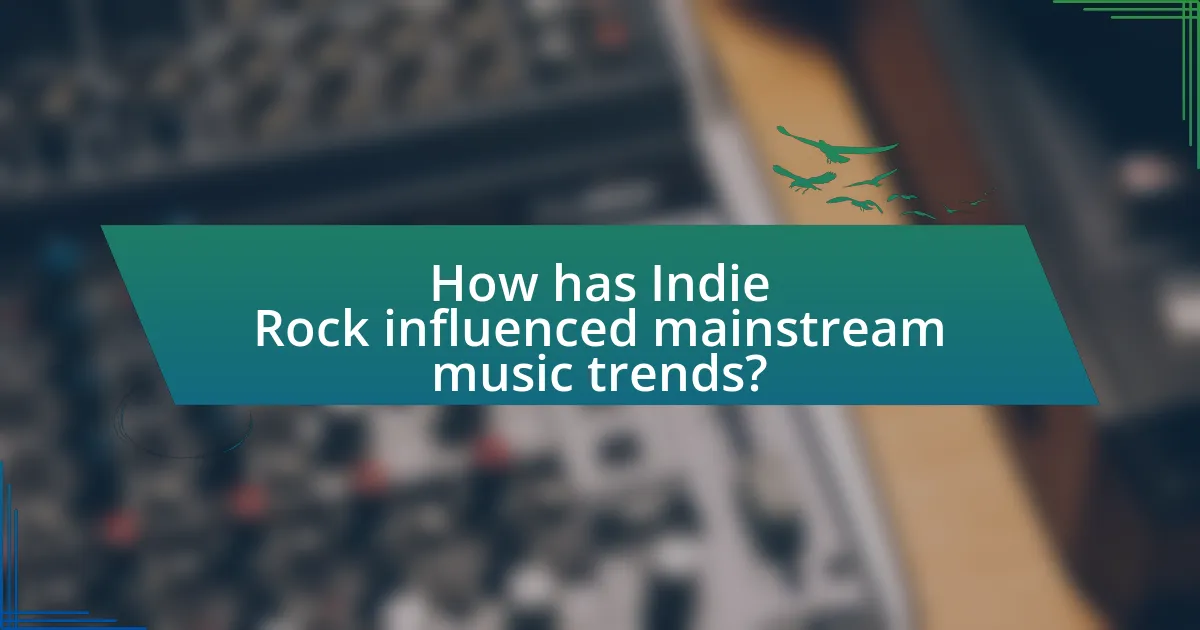
How has Indie Rock influenced mainstream music trends?
Indie Rock has significantly influenced mainstream music trends by introducing diverse sounds, DIY aesthetics, and lyrical authenticity. This genre has led to the incorporation of unconventional song structures and a focus on personal storytelling in popular music. For instance, bands like Arcade Fire and The Strokes have achieved commercial success while maintaining an indie ethos, demonstrating that mainstream artists can adopt indie characteristics without sacrificing popularity. Additionally, the rise of streaming platforms has facilitated the crossover of indie artists into the mainstream, as seen with artists like Tame Impala and Bon Iver, who blend indie sensibilities with broader appeal. This shift has reshaped the music industry, encouraging major labels to sign indie acts and promoting a more eclectic range of sounds in mainstream playlists.
What musical elements from Indie Rock have been adopted by mainstream artists?
Mainstream artists have adopted several musical elements from Indie Rock, including lo-fi production techniques, unconventional song structures, and a focus on authenticity in lyrics. These elements have been integrated into the works of popular artists, such as the use of raw, unpolished soundscapes that characterize many Indie Rock tracks, which can be seen in the music of artists like Billie Eilish and Tame Impala. Additionally, the emphasis on personal and introspective lyrics, often found in Indie Rock, has influenced mainstream songwriting, as evidenced by the lyrical styles of artists like Hozier and Phoebe Bridgers. The blending of genres, a hallmark of Indie Rock, has also been embraced by mainstream musicians, leading to innovative collaborations and cross-genre experimentation.
How have instrumentation and production techniques changed?
Instrumentation and production techniques have evolved significantly, primarily due to advancements in technology and changes in musical trends. The introduction of digital audio workstations (DAWs) has allowed for more complex layering and manipulation of sounds, enabling artists to experiment with diverse instrumentation that was previously difficult to achieve. For instance, the use of synthesizers and electronic elements has become prevalent in indie rock, blending traditional rock instrumentation with modern electronic sounds. Additionally, the rise of home recording has democratized music production, allowing independent artists to produce high-quality recordings without the need for expensive studio time. This shift has led to a more diverse range of sounds and styles in mainstream music, reflecting the influence of indie rock’s experimental approach.
What lyrical themes from Indie Rock have permeated mainstream music?
Lyrical themes from Indie Rock that have permeated mainstream music include introspection, existentialism, and emotional vulnerability. These themes resonate with listeners and have been adopted by mainstream artists, leading to a broader acceptance of personal and often melancholic narratives in popular music. For instance, bands like Death Cab for Cutie and The National have influenced mainstream acts such as Taylor Swift and Hozier, who incorporate similar themes of introspection and emotional depth in their lyrics. This shift reflects a growing trend where mainstream music embraces the authenticity and complexity often found in Indie Rock, demonstrating its significant impact on contemporary songwriting.
Why do mainstream artists collaborate with Indie Rock musicians?
Mainstream artists collaborate with Indie Rock musicians to tap into their unique sound and authenticity, which can enhance the mainstream artist’s creative output and broaden their audience. Collaborations often result in innovative music that blends different styles, appealing to diverse listener demographics. For instance, the collaboration between Taylor Swift and Bon Iver on the song “Exile” showcases how mainstream artists can incorporate Indie Rock elements to create a fresh sound that resonates with both their fan base and Indie music enthusiasts. This strategy not only revitalizes the mainstream artist’s image but also introduces Indie musicians to larger audiences, fostering cross-genre appreciation and collaboration.
What benefits do mainstream artists gain from these collaborations?
Mainstream artists gain increased exposure and access to diverse audiences through collaborations with indie rock musicians. These partnerships allow mainstream artists to tap into the unique sound and creative approaches of indie rock, which can enhance their artistic credibility and innovation. For instance, collaborations often lead to cross-promotion, where both artists benefit from each other’s fan bases, resulting in higher streaming numbers and concert attendance. Additionally, mainstream artists can leverage the authenticity associated with indie rock to appeal to listeners seeking originality, thereby broadening their market reach and sustaining relevance in a competitive industry.
How do these collaborations affect the perception of Indie Rock?
Collaborations between Indie Rock artists and mainstream musicians enhance the perception of Indie Rock by broadening its audience and increasing its legitimacy. These partnerships often introduce Indie Rock to listeners who may not typically engage with the genre, thereby expanding its reach. For instance, collaborations like those between Bon Iver and Taylor Swift or The National and Taylor Swift have brought Indie Rock elements into the pop mainstream, demonstrating its versatility and appeal. This crossover not only elevates the status of Indie Rock but also encourages a fusion of styles, leading to innovative sounds that attract diverse listeners. As a result, the genre is increasingly viewed as a significant and influential force within the broader music landscape.
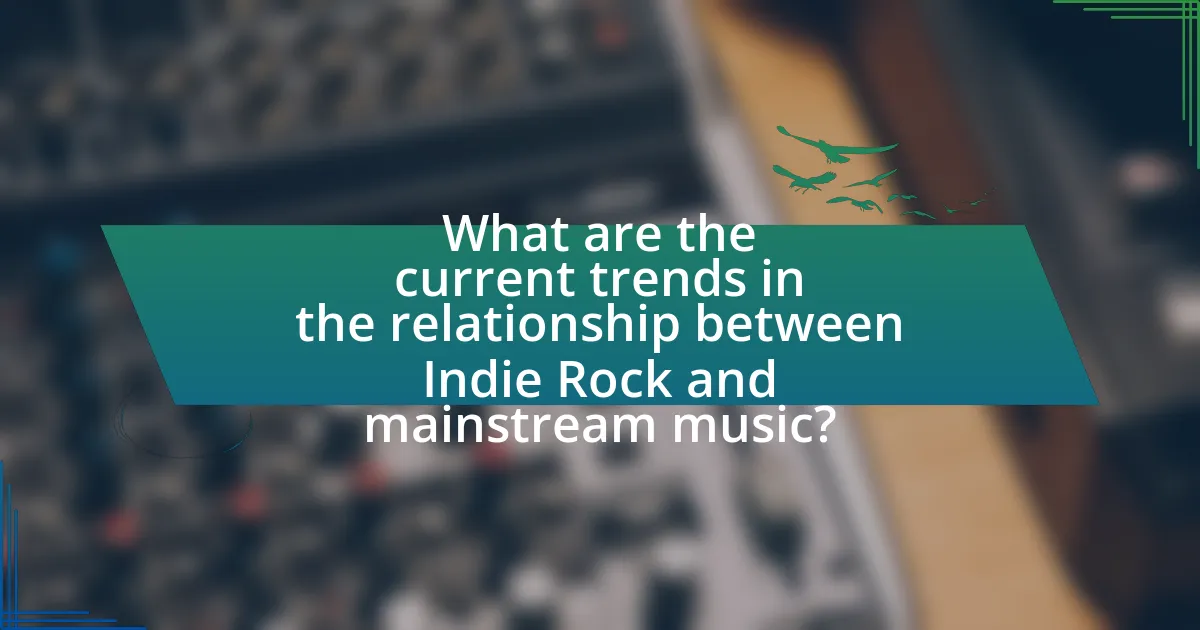
What are the current trends in the relationship between Indie Rock and mainstream music?
Current trends indicate that Indie Rock is increasingly influencing mainstream music, with many mainstream artists incorporating Indie elements into their sound. This trend is evidenced by the rise of collaborations between Indie Rock bands and major pop artists, as seen in tracks like “Stay” by The Kid LAROI and Justin Bieber, which features an Indie-inspired production style. Additionally, streaming platforms have facilitated the crossover of Indie Rock artists into mainstream charts, with bands like Tame Impala achieving significant commercial success while maintaining their Indie identity. This blending of genres reflects a growing acceptance of diverse musical styles within the mainstream music landscape.
How has the digital age affected the influence of Indie Rock?
The digital age has significantly amplified the influence of Indie Rock by providing artists with unprecedented access to distribution channels and audience engagement platforms. With the rise of streaming services like Spotify and platforms such as Bandcamp, Indie Rock musicians can now reach global audiences without the need for traditional record labels. This shift has led to a diversification of sounds and styles within the genre, as artists can experiment and share their music more freely. According to a 2021 report by the International Federation of the Phonographic Industry, independent labels accounted for 40% of global music sales, highlighting the substantial impact of digital platforms on the Indie Rock scene.
What role do streaming platforms play in promoting Indie Rock?
Streaming platforms play a crucial role in promoting Indie Rock by providing artists with accessible distribution channels and broad audience reach. These platforms, such as Spotify and Apple Music, enable independent musicians to upload their music without the need for traditional record labels, thus democratizing access to the music industry. According to a 2021 report by the International Federation of the Phonographic Industry, over 60% of music consumption now occurs through streaming, highlighting its significance in shaping listener habits. Additionally, curated playlists on these platforms often feature Indie Rock tracks, which can significantly increase an artist’s visibility and listener engagement. This exposure can lead to increased concert attendance and merchandise sales, further solidifying the genre’s presence in the mainstream music landscape.
How has social media changed the landscape for Indie Rock artists?
Social media has significantly transformed the landscape for Indie Rock artists by providing them with direct access to audiences and enabling self-promotion without traditional gatekeepers. This shift allows artists to share their music, engage with fans, and build a following through platforms like Instagram, Twitter, and TikTok, which collectively have billions of active users. For instance, a study by the Pew Research Center indicates that 72% of the public uses some form of social media, highlighting its role in music discovery. Additionally, viral trends on platforms like TikTok can propel Indie Rock songs into mainstream popularity, as seen with tracks like “Riptide” by Vance Joy, which gained traction through user-generated content. This democratization of music distribution has allowed Indie Rock artists to thrive independently, fostering a diverse musical landscape.
What future trends can we expect in the Indie Rock and mainstream music relationship?
Future trends in the relationship between Indie Rock and mainstream music will likely include increased collaboration and genre blending. As mainstream artists seek authenticity and unique sounds, they are increasingly turning to Indie Rock musicians for inspiration and collaboration, leading to a fusion of styles that appeals to broader audiences. For instance, the rise of platforms like Bandcamp and SoundCloud has enabled Indie artists to gain visibility, influencing mainstream music trends and encouraging major labels to adopt more diverse sounds. This trend is supported by data showing that Indie Rock’s influence has grown, with artists like Billie Eilish and Tame Impala incorporating Indie elements into their mainstream hits, reflecting a shift towards more eclectic musical landscapes.
How might emerging genres continue to blend with Indie Rock influences?
Emerging genres are likely to continue blending with Indie Rock influences through the incorporation of its characteristic DIY ethos, melodic structures, and eclectic instrumentation. This blending occurs as artists from genres such as electronic, hip-hop, and pop increasingly draw inspiration from Indie Rock’s emphasis on authenticity and experimentation. For instance, the rise of artists like Billie Eilish and Tame Impala showcases how electronic elements and introspective lyrics can coexist with traditional rock sensibilities, reflecting a seamless integration of styles. Additionally, collaborations between Indie Rock musicians and artists from other genres further facilitate this fusion, creating innovative sounds that resonate with diverse audiences.
What strategies can Indie Rock artists use to maintain relevance in mainstream music?
Indie Rock artists can maintain relevance in mainstream music by leveraging social media platforms for direct engagement with fans and utilizing streaming services for wider distribution. Social media allows artists to build a loyal fanbase and promote their music effectively; for instance, platforms like Instagram and TikTok have been instrumental in launching viral music trends. Additionally, streaming services such as Spotify and Apple Music provide access to a global audience, enabling Indie Rock artists to reach listeners who may not have discovered them otherwise. According to a 2021 report by the International Federation of the Phonographic Industry, streaming accounted for 62% of global recorded music revenue, highlighting its importance in the current music landscape. By embracing these digital tools, Indie Rock artists can adapt to changing consumer behaviors and remain relevant in a competitive industry.
What are some best practices for Indie Rock artists to navigate mainstream success?
Indie Rock artists can navigate mainstream success by maintaining their unique sound while strategically engaging with broader audiences. This involves leveraging social media platforms for direct fan interaction, which has proven effective; for instance, artists like Chance the Rapper gained significant traction through platforms like Twitter and Instagram, fostering a loyal fanbase. Additionally, collaborating with mainstream artists can enhance visibility without compromising artistic integrity, as seen with bands like Bon Iver, who collaborated with Taylor Swift, reaching new audiences. Furthermore, participating in music festivals that attract diverse crowds can help Indie Rock artists gain exposure; events like Coachella have historically showcased Indie acts that later achieved mainstream success. Lastly, focusing on high-quality production and marketing can elevate an artist’s profile, as demonstrated by the rise of bands like Tame Impala, who combined innovative sound with professional promotion.
